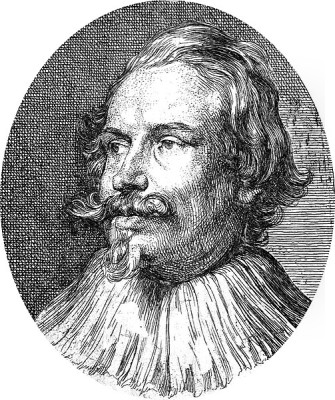
Paul de Vos stands as a significant figure in the vibrant artistic landscape of 17th-century Flanders. A prominent member of the Antwerp school during the Baroque period, he carved a distinct niche for himself as a specialist painter of animals, dynamic hunting scenes, and opulent still lifes. Active during a golden age of Flemish art, De Vos worked alongside and collaborated with giants like Peter Paul Rubens and Anthony van Dyck, yet developed a powerful style uniquely his own, characterized by energy, meticulous detail, and dramatic flair. His large-scale canvases, often teeming with life and action, adorned the collections of European aristocracy, securing his reputation as a master of his chosen genres.
From Hulst to Antwerp: Early Years and Formation
Paul de Vos was born in Hulst, located in the province of Zeeland, which was then part of the Dutch Republic but is now in the Netherlands, close to the border with modern Belgium. Sources suggest a birth year around 1591/1592, though some place it slightly later, around 1595. His family, like many others during this period of religious and political turmoil, relocated to the thriving artistic and commercial hub of Antwerp. It was here that Paul, along with his elder brother Cornelis de Vos, who would become a renowned portraitist, embarked on his artistic training.
Records indicate that Paul de Vos began his apprenticeship in 1599 under the relatively obscure painter David Remeeus. He continued his training with Remeeus until at least 1604. While his brother Cornelis quickly established himself, Paul's path seems to have focused early on the depiction of the natural world. He officially became a master in the prestigious Antwerp Guild of Saint Luke in 1620, a crucial step confirming his status as an independent professional artist in the city. This membership allowed him to establish his own workshop, take on pupils, and sell his works freely.
The Development of a Specialist
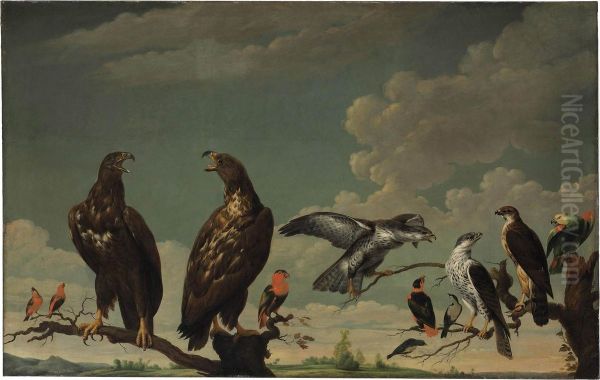
While his brother Cornelis excelled in portraiture and historical scenes, Paul de Vos dedicated his considerable talents primarily to animal painting, hunting scenes, and elaborate still lifes, particularly 'pantry scenes' or 'larder scenes'. This specialization was not uncommon in Antwerp, where artists often focused on specific genres to meet the demands of a sophisticated market. De Vos's chosen subjects were particularly popular among the aristocracy and wealthy merchant class, who appreciated depictions of the hunt, a noble pastime, and displays of abundance and wealth in still life compositions.
His focus allowed him to develop an extraordinary skill in rendering animal anatomy, fur, and feathers with convincing realism. He possessed a keen observational ability, capturing the characteristic movements and behaviours of various creatures, from domestic animals and birds to wild beasts engaged in dramatic struggles for survival. This specialization placed him in direct dialogue, and sometimes friendly rivalry, with his contemporary and eventual brother-in-law, Frans Snyders, the other preeminent animal painter in Antwerp at the time.
Hallmarks of Style: Dynamism and Detail
Paul de Vos's style is firmly rooted in the Flemish Baroque tradition, characterized by its energy, rich colours, and dramatic intensity. His works often display a more dynamic and sometimes more overtly violent approach compared to Frans Snyders. De Vos excelled at composing large, complex scenes filled with movement and narrative tension. His brushwork could be vigorous and expressive, particularly in depicting the frenzy of a hunt or the struggle between animals, yet he was also capable of rendering textures and details with remarkable precision.
The influence of Peter Paul Rubens is palpable in the dynamism and monumental scale of many of De Vos's compositions. He absorbed Rubens's ability to orchestrate complex figural groups and infuse scenes with dramatic energy. There are also echoes of Anthony van Dyck's elegance in some of his depictions, particularly in the rendering of certain textures or the graceful lines of animals at rest. However, De Vos synthesized these influences into a personal style, marked by a specific focus on the animal world, often depicted with an almost visceral intensity. His colour palette was typically rich and varied, contributing to the overall vitality of his canvases.
The Thrill of the Hunt
Hunting scenes form a significant and perhaps the most characteristic part of Paul de Vos's oeuvre. These large-scale canvases often depict dramatic moments of the chase: packs of hounds bringing down a stag, hunters closing in on a wild boar, or fierce encounters between predators and prey. De Vos masterfully conveyed the speed, energy, and brutality of the hunt. His dogs leap and snarl, their muscles straining, while their quarry is shown in attitudes of desperate flight or ferocious defence.
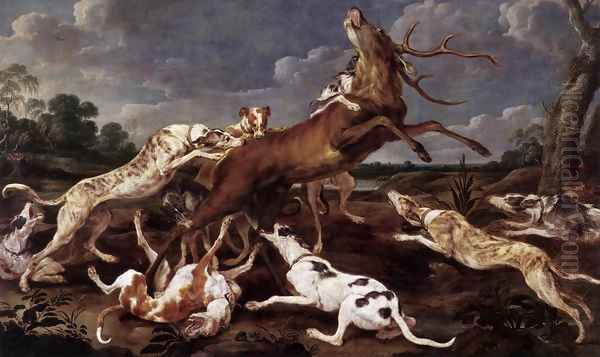
These paintings were highly sought after by aristocratic patrons, for whom hunting was both a favoured pastime and a symbol of power and status. De Vos's ability to capture the excitement and danger of the chase resonated with his clientele. He demonstrated a profound understanding of animal anatomy and behaviour, lending authenticity to these often violent spectacles. Works like the numerous hunting scenes found in collections such as the Prado Museum in Madrid or the Kunsthistorisches Museum in Vienna exemplify his mastery of this genre.
Abundance and Allegory: Still Life Paintings
Alongside his hunting scenes, Paul de Vos produced impressive still life paintings, particularly large 'pantry' or 'larder' scenes. These compositions typically feature a lavish display of dead game, poultry, fish, lobsters, fruits, vegetables, and kitchenware, often arranged in a kitchen or pantry setting, sometimes with figures (often added by other artists) or live animals interacting with the display. A prime example is The Pantry (Spiżarnia), housed in the National Museum in Gdańsk, Poland.
These works served as displays of wealth and abundance, celebrating the bounty of nature and the prosperity of the household. However, like many Baroque still lifes, they could also carry deeper allegorical meanings. The juxtaposition of live animals (like cats eyeing the game) with dead ones, or the inclusion of luxurious but perishable items, could serve as a vanitas message – a reminder of the transience of life and earthly pleasures. The sheer opulence depicted might also implicitly comment on luxury and consumption in 17th-century society. De Vos handled these complex arrangements with compositional skill, balancing the numerous elements and rendering textures with convincing realism.
Animal Worlds: Beyond the Hunt
While famous for his dramatic hunts, Paul de Vos also painted animals in other contexts. His repertoire included depictions of stables with horses, farmyard scenes, and compositions focusing solely on groups of animals. One notable example is the Concert of Birds, a theme also explored by Frans Snyders. In such works, various species of birds are gathered together, often perched on branches, seemingly engaged in a musical performance led by an owl.
These charming paintings likely held allegorical meanings related to harmony, natural order, or perhaps even social satire, depending on the specific birds depicted and their arrangement. They showcase De Vos's versatility and his ability to capture the individual character of different species beyond the context of violent struggle. These works demonstrate his broader interest in the animal kingdom and his skill in detailed observation and lively characterization.
A Network of Collaboration: Working with Masters
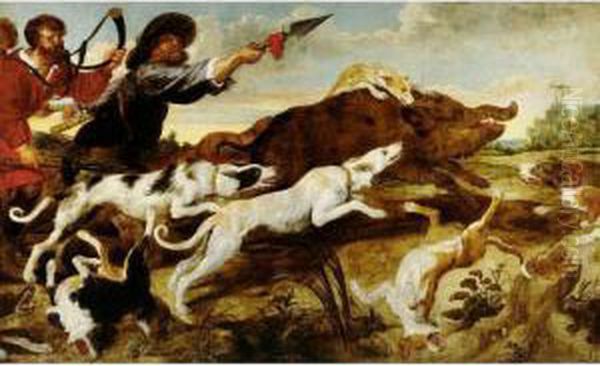
Collaboration between specialist artists was a hallmark of the Antwerp school in the 17th century, and Paul de Vos was deeply integrated into this network. His most significant collaboration was undoubtedly with Peter Paul Rubens. De Vos worked as an assistant or collaborator on major projects commissioned from Rubens's workshop, particularly large decorative cycles. Notably, both Paul and his brother Cornelis de Vos contributed to the series of paintings commissioned by King Philip IV of Spain in the 1630s for his hunting lodge, the Torre de la Parada, near Madrid. Paul likely painted many of the animal elements and hunting scenes based on Rubens's designs (oil sketches). He also contributed to decorations for the Buen Retiro Palace in Madrid.
Paul de Vos also had a close professional and personal relationship with Frans Snyders. Snyders married Paul's sister, Margaretha, making them brothers-in-law. While they were the leading animal painters in Antwerp and potentially rivals, evidence suggests they also collaborated or at least shared workshop resources and influenced each other significantly. Some works are attributed jointly or show clear stylistic overlap. De Vos is known to have sometimes imitated Snyders' compositions early in his career.
Furthermore, De Vos collaborated with figure painters who would add human staffage to his still lifes or landscapes, and he likely provided the animal elements for works by other masters. He is known to have worked with the landscape painter Jan Wildens (who was also his brother-in-law, having married Frans Snyders' sister Maria), who sometimes provided the landscape settings for De Vos's animal scenes. Other artists active in these collaborative circles included Jacob Jordaens and Theodoor van Thulden, who also worked on the Torre de la Parada project, and figure painters like Erasmus Quellinus II and Jan Cossiers.
Spotlight on Masterpieces
Several works stand out in Paul de Vos's extensive production. The Pantry (Spiżarnia) in Gdańsk is a quintessential example of his large-scale still life work, showcasing a dazzling array of game, produce, and kitchen items, rendered with meticulous detail and rich colour, embodying themes of abundance and perhaps transience.
The Concert of Birds, versions of which exist in various collections (including potentially the Rijksmuseum in Amsterdam, though attributions can be complex between De Vos and Snyders), represents his lighter, more allegorical side. These compositions are celebrated for their charming depiction of diverse bird species and their intricate arrangements.
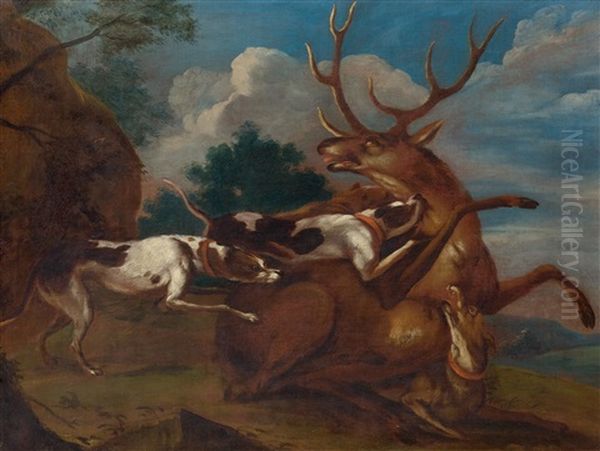
His hunting scenes in the Prado Museum, Madrid, many resulting from the Torre de la Parada commission or similar royal patronage, are among his most famous works. Paintings like Stag Hunt or Boar Hunt exemplify his ability to capture the raw energy and drama of the chase on a monumental scale, showcasing his mastery of animal anatomy in motion and his dynamic compositional skills. A Hunting Scene in the Kunsthistorisches Museum, Vienna, further attests to his renown in this genre across European courts.
The De Vos-Snyders Artistic Dynasty
Paul de Vos was part of a highly interconnected artistic milieu in Antwerp, linked by family ties as well as professional collaboration. His elder brother, Cornelis de Vos (c. 1584–1651), was a highly successful painter specializing in portraits, particularly group portraits, and also historical and religious subjects. Cornelis served as Dean of the Guild of Saint Luke and enjoyed considerable prestige.
Paul's sister, Margaretha de Vos, married Frans Snyders (1579–1657), arguably the most famous Flemish animal and still-life painter of the era. This marriage created a direct family link between two leading specialists in similar fields. Furthermore, Snyders' sister, Maria, married the landscape painter Jan Wildens (1586–1653), bringing another important artist into this extended family network. Paul de Vos's nephew (Cornelis's son), Simon de Vos (1603–1676), also became a painter, though his style differed, focusing more on small-scale cabinet paintings and genre scenes. Other artists connected to this circle through training or collaboration included Jan Fyt (Snyders' most important pupil and a major animal painter in his own right), Adriaen van Utrecht (another prominent still-life painter), Pieter Boel, and David de Coninck (later animal painters influenced by this tradition). The father-in-law of Cornelis de Vos was the painter Marten Pepijn. This dense web of relationships fostered artistic exchange and shaped the character of Antwerp painting.
Royal and Aristocratic Patronage
The scale and ambition of Paul de Vos's works were often driven by prestigious commissions from high-ranking patrons. His involvement in the projects for King Philip IV of Spain (Torre de la Parada, Buen Retiro) highlights his standing at the highest levels. These commissions, often mediated through Rubens, provided De Vos with opportunities to work on a monumental scale and demonstrate his skills to an international audience.
He also received commissions from the governors of the Spanish Netherlands, such as the Cardinal-Infante Ferdinand of Austria, and later Archduke Leopold Wilhelm of Austria, both significant art patrons. Local Flemish aristocracy and wealthy burghers also sought out his works, particularly the dynamic hunting scenes and opulent still lifes that reflected their status and interests. This consistent demand from elite clientele ensured De Vos's financial success and allowed him to maintain a productive workshop.
Dissemination and Lasting Impact
Paul de Vos's influence extended beyond his original paintings. Like many successful artists of the period, his compositions were disseminated through prints. Engravers associated with Rubens's circle, such as Schelte a Bolswert and Paulus Pontius, may have reproduced his works, allowing his designs to reach a wider audience across Europe and serve as models for other artists.
His powerful and dynamic style of animal painting, particularly his hunting scenes, had a lasting impact on subsequent generations of Flemish artists specializing in this genre, including Jan Fyt, Pieter Boel, and David de Coninck. He, along with Frans Snyders, solidified animal painting and the grand still life as major, respected genres within Flemish Baroque art. His ability to combine anatomical accuracy with dramatic energy set a high standard for animal depiction.
Paul de Vos in Museum Collections
Today, works by Paul de Vos can be found in major museums around the world, attesting to his historical importance and enduring appeal. The Museo Nacional del Prado in Madrid holds a particularly strong collection, reflecting his extensive work for the Spanish crown, including several large hunting scenes and collaborations. The Kunsthistorisches Museum in Vienna also possesses significant examples of his hunting scenes.
Other key institutions include the National Museum in Gdańsk (home to The Pantry), the Rijksmuseum in Amsterdam, the Royal Museums of Fine Arts of Belgium in Brussels, the Royal Museum of Fine Arts Antwerp (KMSKA), and the Museum Plantin-Moretus in Antwerp. Major museums like the Louvre in Paris, the Hermitage Museum in St. Petersburg, and various collections in the United Kingdom and the United States also house works by Paul de Vos, ensuring his art remains accessible to scholars and the public.
Conclusion: A Force in Flemish Baroque
Paul de Vos was a formidable talent within the powerhouse of the Antwerp school during the 17th century. While perhaps sometimes overshadowed in general art history by the towering figures of Rubens and Van Dyck, he was a master in his own right within his chosen specializations. His dynamic and often dramatic depictions of animals, hunts, and abundant still lifes were executed with remarkable skill and energy. Through his prolific output, his collaborations with leading masters, and his influence on subsequent artists, Paul de Vos made a significant and lasting contribution to the richness and diversity of Flemish Baroque art. His canvases continue to impress viewers today with their vitality, detail, and masterful command of the animal form.